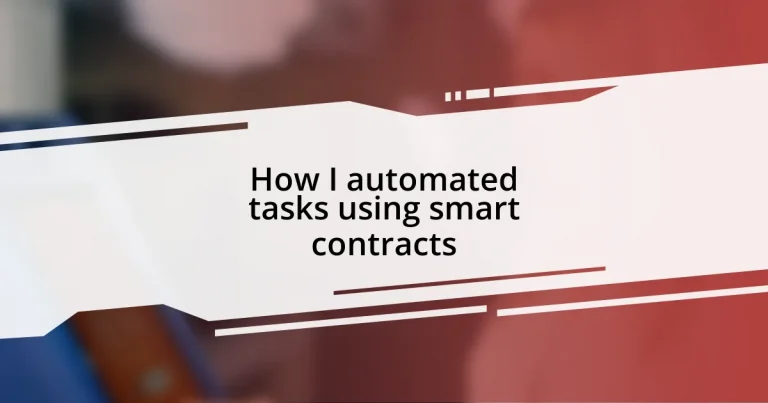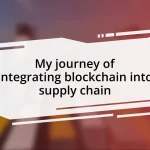Key takeaways:
- Smart contracts automate agreements on a blockchain, enhancing transaction speed, cost efficiency, and security without intermediaries.
- Identifying tasks for automation hinges on factors like repetitiveness, clarity of rules, and data-driven processes.
- Choosing an appropriate blockchain platform involves assessing scalability, transaction speed, and community support, with a preference for energy-efficient consensus mechanisms.
- Effective testing and security audits are critical before deploying smart contracts to prevent vulnerabilities and ensure smooth operations.
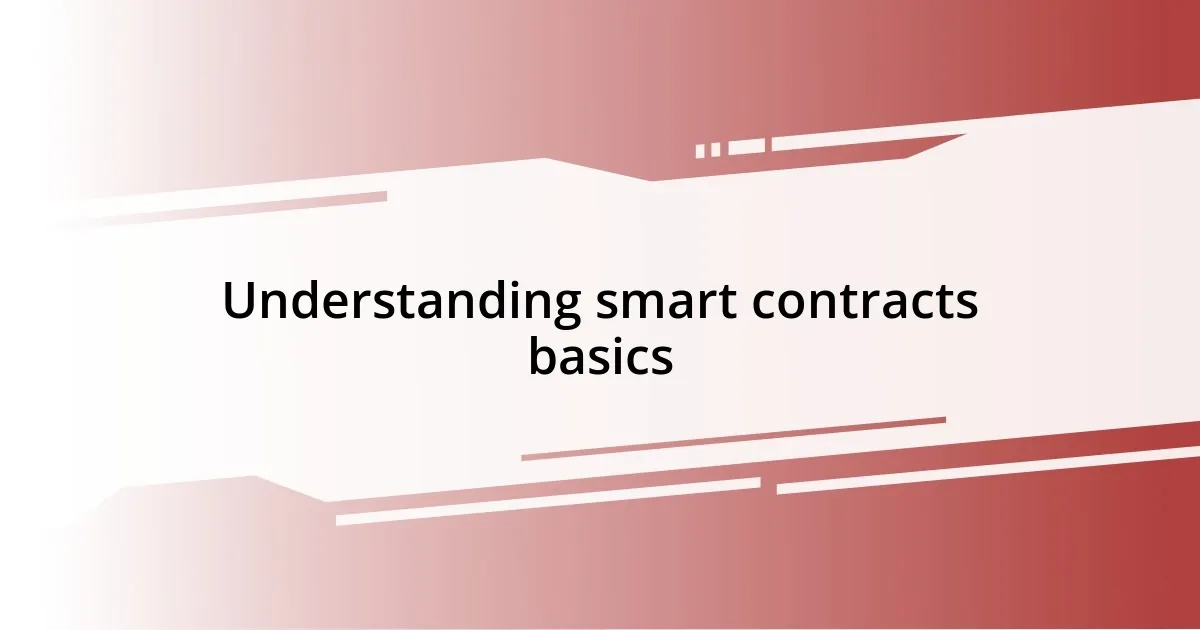
Understanding smart contracts basics
Smart contracts are essentially self-executing contracts with the terms of the agreement directly written into code on a blockchain. I remember when I first encountered this concept; it felt like stepping into a sci-fi movie where automation was the key character. The beauty lies in how they eliminate the need for intermediaries, which not only makes transactions faster but also significantly reduces costs.
When I first started using smart contracts, I was amazed at their transparency and security. Each transaction is recorded on the blockchain, making it immutable and accessible for verification anytime. Have you ever wondered what it feels like to trust a system so inherently? It’s both liberating and empowering, knowing that the contract cannot be tampered with once deployed.
One crucial aspect that struck me was the versatility of smart contracts across various industries. From finance to supply chain management, their potential seems limitless. Can you imagine a world where your business agreements execute automatically, without constant management? That prospect is not just theoretical; it’s very much a reality today. It opens up a new realm of possibilities for efficiency and trust in our transactions.
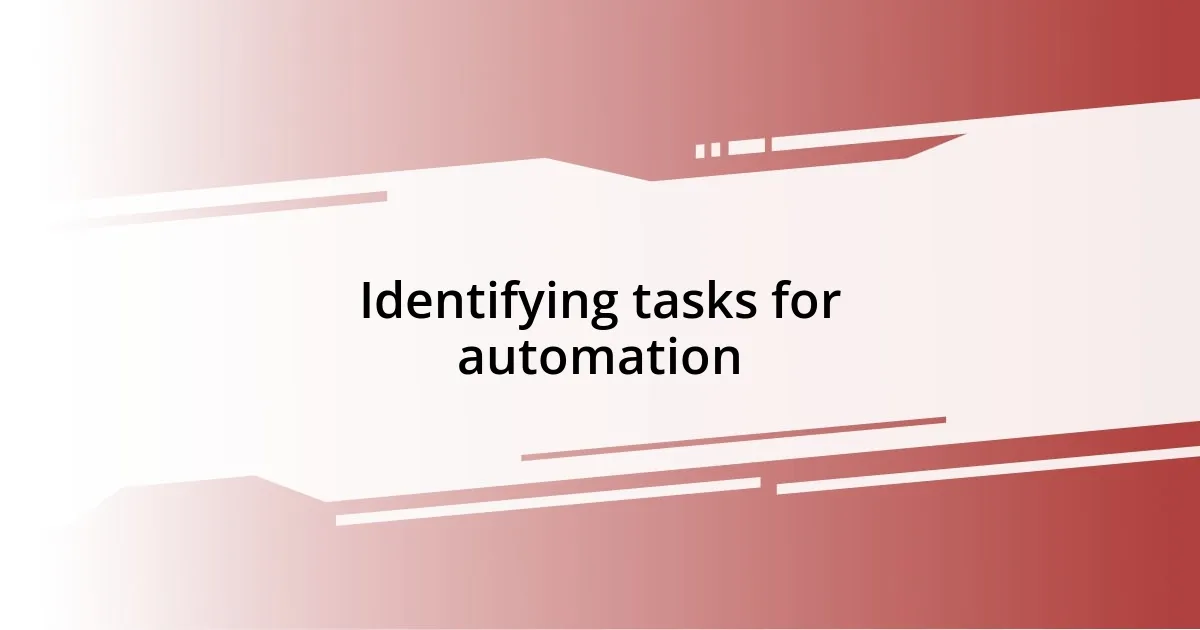
Identifying tasks for automation
Identifying tasks suitable for automation can be a game-changer for efficiency. My experience taught me that not all tasks are created equal when it comes to automation. Some are repetitive and straightforward, making them prime candidates for smart contracts. Others, however, may still need a human touch. During my journey, I found that analyzing tasks based on frequency and complexity was essential. This approach helped me pinpoint which tasks would benefit most.
Here are some indicators that a task is ripe for automation:
- Repetitiveness: Tasks performed often can lead to automation savings.
- Clarity of rules: If the task follows clear guidelines, it’s easier to code.
- Time-consuming: Long tasks can drain resources and energy, so automation can enhance productivity.
- Low variability: Processes that don’t change much over time work well with automation.
- Data-driven: Tasks relying heavily on data input often lend themselves to smart contract execution.
Reflecting on my own workflow, I can’t help but recall the sigh of relief I felt when I automated invoice processing. The time I once spent on manual entries transformed into moments I could invest elsewhere. It’s these small victories that fuel my passion for leveraging technology in everyday tasks.
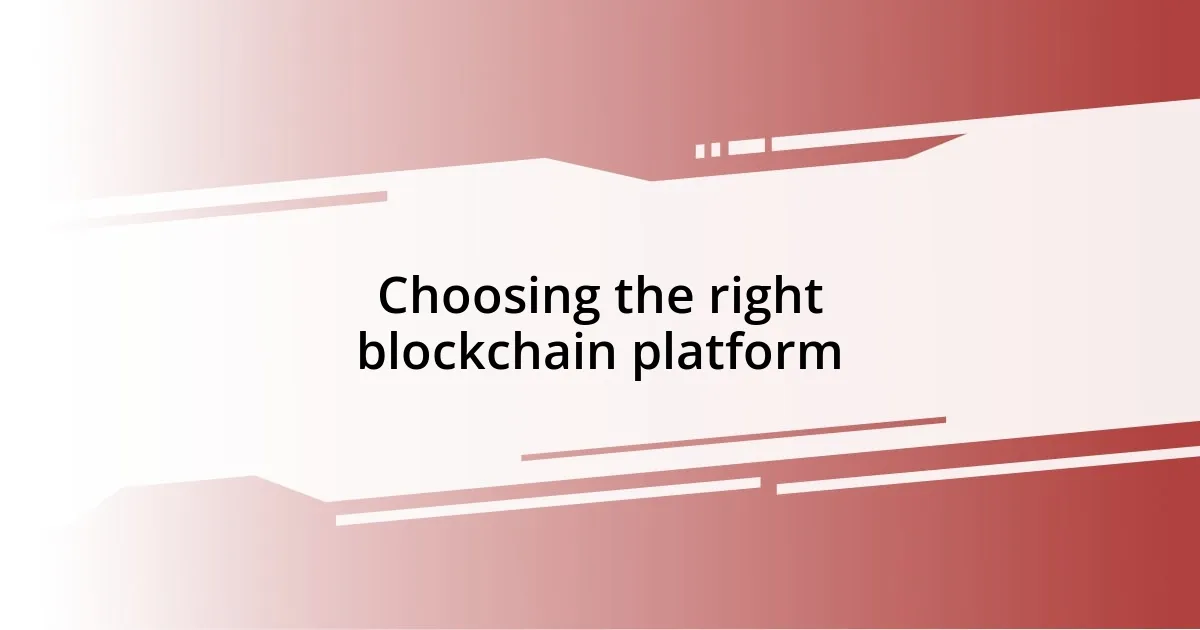
Choosing the right blockchain platform
When choosing the right blockchain platform, it’s crucial to consider your specific needs and objectives. Not all platforms are created equal; each has its strengths and limitations. I recall a time when I had to select a platform for a new project. I found myself weighing factors like scalability and transaction speed. The experience was intense, yet enlightening.
The consensus mechanism—how participants agree on the validity of transactions—can greatly impact your project’s performance. For example, I leaned towards platforms using Proof of Stake (PoS) because they tend to be more energy-efficient compared to those using Proof of Work (PoW). This decision not only aligned with my values regarding sustainability but also improved transaction speeds for my tasks. You might want to consider how much energy and time you’re willing to invest into the platform as well.
Lastly, it’s essential to evaluate the development community supporting the platform. I once underestimated this aspect and faced hurdles later on that could have been easily avoided. A robust community means better support, more resources, and continuous improvements. Imagine embarking on a journey with a guide who knows every twist and turn; that’s what a strong community feels like!
| Blockchain Platform | Consensus Mechanism | Transaction Speed | Community Support |
|---|---|---|---|
| Ethereum | Proof of Work (transitioning to PoS) | 15-30 sec | Large |
| Cardano | Proof of Stake | 5-10 sec | Growing |
| Binance Smart Chain | Proof of Staked Authority | 3 sec | Large |
| Polkadot | Variation of PoS | 6-12 sec | Active |

Writing your first smart contract
Writing your first smart contract can feel like stepping into uncharted territory, but I found it incredibly rewarding. It all begins with understanding the language of the blockchain. For instance, I started with Solidity, the primary language for writing smart contracts on the Ethereum network. I vividly recall the thrill of writing my first function; it felt like unlocking a new skill set. Isn’t it fascinating how a few lines of code can create agreements that execute automatically?
As I dove deeper, I realized that structuring my contract clearly is essential. Each function needs a defined purpose, and I often found it helpful to sketch out the logic on paper first. This planning phase not only prevented confusion later but also saved me from potential pitfalls. I remember staring at my screen, only to realize that a misplaced semicolon had caused an error that took me hours to debug. Believe me, keeping my structure tidy and organized made the process smoother!
Once my contract was drafted, deploying it was a mix of excitement and apprehension. Watching it go live felt monumental, almost like sending a child off into the world. I managed to test it on a testnet first, which allowed me to experiment without financial stakes. Looking back, that cautious step was invaluable; it prepared me for the intricacies of real-world deployment. Have you ever felt that rush of anticipation when unveiling a project? It’s that blend of fear and exhilaration that makes creating smart contracts truly unique.
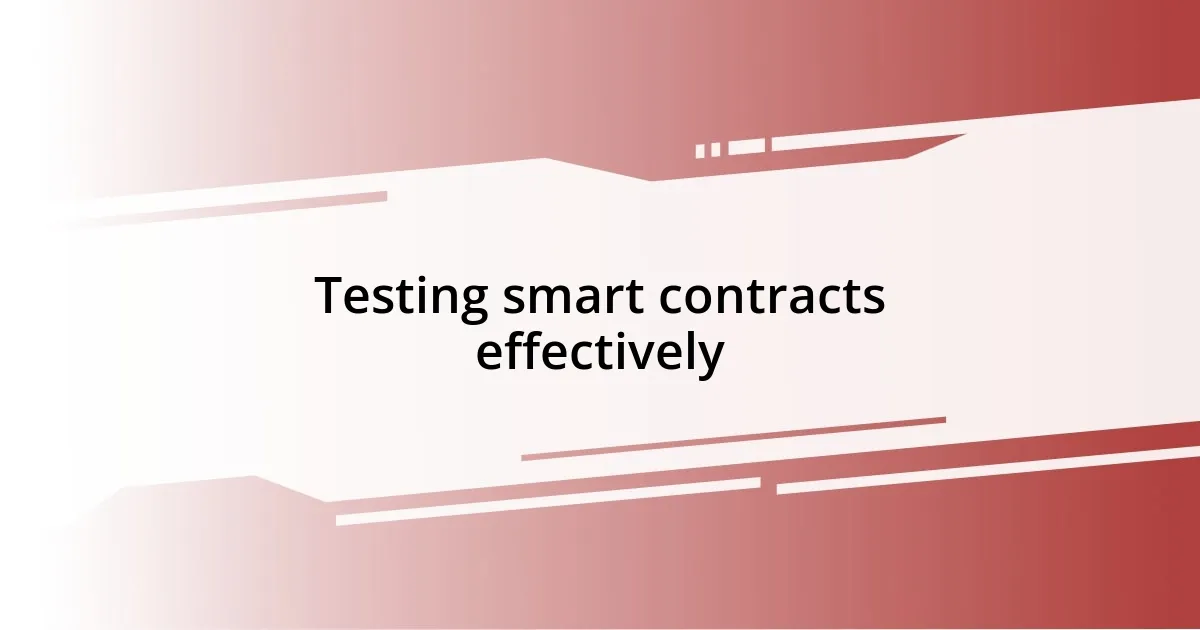
Testing smart contracts effectively
Testing smart contracts effectively is a crucial step that I’ve learned not to overlook. When I first started, I quickly discovered that even the smallest error could lead to significant consequences—something I experienced firsthand. I put a contract through the wringer using various testing frameworks like Truffle and Hardhat. Each framework has its quirks, but they all helped me catch bugs before any real money was on the line. Can you imagine the horror of deploying a faulty contract?
Simulating different scenarios is also a strategy I highly recommend. One day, while testing a contract related to a crowdfunding project, I ran simulations to see how it would behave under various conditions, like insufficient funds or sudden large contributions. This particular exercise was eye-opening; it unveiled potential vulnerabilities I hadn’t anticipated. It’s almost like being a detective—solving puzzles that could impede your contract’s success.
Lastly, peer reviews are worth their weight in gold. On one occasion, I had a fellow developer go through my contract’s code before it was deployed. Having another set of eyes on your work can reveal blind spots. I remember the relief I felt when they spotted a logic flaw that I had missed. Why not bounce ideas off someone else? Sometimes, collaboration can lead to insights you’d never arrive at alone.
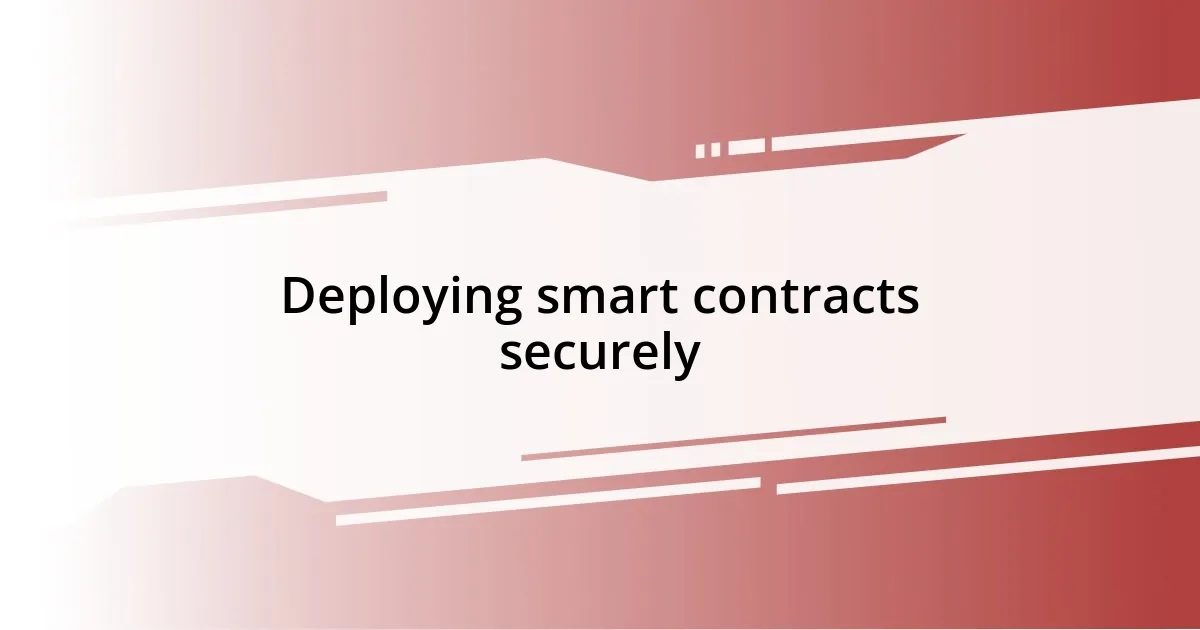
Deploying smart contracts securely
Securing the deployment of smart contracts is paramount, and I learned this the hard way. I vividly recall when I rushed a deployment, thinking I could skimp on security measures. It wasn’t until I received a frantic call from a partner about a vulnerable function that I realized the weight of that mistake. Have you ever overlooked a detail only to feel the consequences later? Trust me, a thorough security audit is not merely a suggestion—it’s essential.
One effective strategy I adopted was leveraging tools like Mythril and Slither to scan my contracts before going live. These automated tools can highlight potential vulnerabilities that might escape a regular review. I remember marveling at how they picked up on issues I had completely missed. In this digitally interconnected world, why would you risk the security of your contracts by skipping this crucial step? It’s always better to catch something before it bites!
Additionally, incorporating role-based access controls was a game-changer for me. I put into practice the principle of least privilege, ensuring that each function could only be accessed by those who absolutely needed it. This method helped me sleep better at night, knowing that my contracts were less exposed to malicious actors. It’s like locking the doors to your house; wouldn’t you want to secure your hard work? Balancing functionality with security has become my guiding mantra, and it’s something I encourage every developer to embrace.
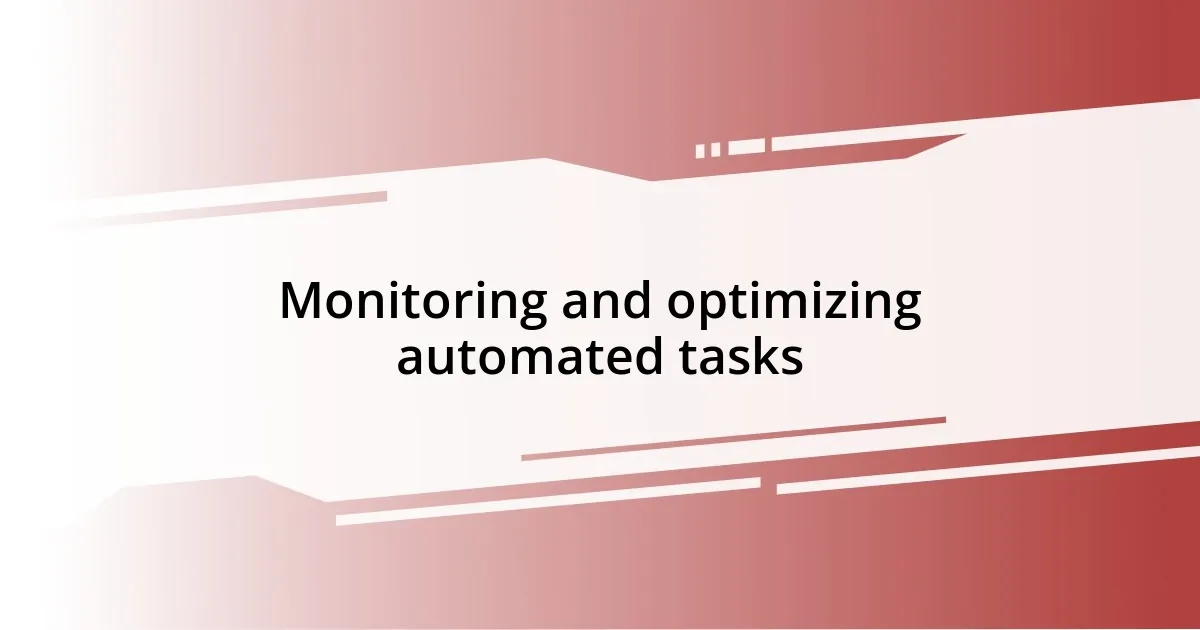
Monitoring and optimizing automated tasks
Monitoring automated tasks effectively is an ongoing process that can be both rewarding and challenging. I once implemented a monitoring system that used event logs and real-time notifications. The moment a task failed, I was alerted, allowing me to troubleshoot immediately. It felt empowering to have that kind of oversight—kind of like having a safety net under a high-wire act. Who wouldn’t want to catch issues before they escalate?
Optimizing these tasks is where the real magic happens. I’ve experimented with adjusting parameters based on data insights. For example, after analyzing the performance of a contract during high traffic times, I found that tweaking the execution gas limits led to smoother operations and reduced costs. Have you ever tweaked a recipe just right? That satisfaction of knowing you made something work better—it’s a rush!
Feedback loops are essential for continuous improvement. I remember collecting user feedback on a contract I developed to automate payments. Hearing users’ insights not only helped me identify faults but also inspired new features that enhanced usability. It’s like having a conversation with your users—what do they truly want? Engaging with them actively turned my automated task into a tool that genuinely met their needs.












